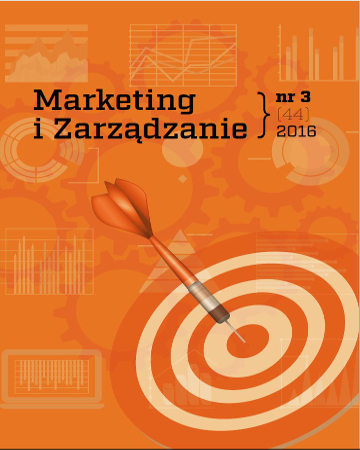
ISSN: 2450-775X
eISSN: 2353-2874
OAI
DOI: 10.18276/miz.2016.44-29



Issue archive /
nr 3 (44) 2016
Shadow brands – exploring phenomenon of meaningless brands
| Authors: |
Małgorzata
Karpińska-Krakowiak
Uniwersytet Łódzki, Wydział Studiów Międzynarodowych i Politologicznych |
| Keywords: | brand significance brand meaning shadow brand researcher metaphor |
| Data publikacji całości: | 2016 |
| Page range: | 10 (317-326) |
| Klasyfikacja JEL: | D10 M30 |
Abstract
Marketing practitioners believe in high significance of their brands and high utility of their products. They perpetuate a viewpoint of brands serving as mental shortcuts, which facilitate purchase decisions, and they consider brands to be highly important throughout the whole consumption process. Interestingly, there exist some premises which suggest that the role of brands in consumers’ lives is overestimated. The objective of the present study was therefore to gain insight into this phenomenon and examine the real importance of brands in consumers’ everydayness. A researcher metaphor of a shadow brand was introduced and diverse qualitative methods were applied. The initial findings suggest that almost all consumed brands remain overshadowed; high involvement brands can be equally meaningless as low involvement ones; neither purchase frequency, perceived quality, nor trust, increase probability of moving a brand out of shadow.
Download file
Article file
Bibliography
| 1. | Aaker, J. (1997). Dimensions of brand personality. Journal of Marketing Research, 34 (August), 347‒356. |
| 2. | Adamkiewicz, K., Ulatowska-Szostak, E., Marcinkowski, J.T. (2011). Najważniejsze czynniki skłaniające konsumentów do zakupu kosmetyków. Hygiea Public Health, 46 (4), 467‒470. |
| 3. | Albert, N., Merunka, D. (2013). The role of brand love in consumer-brand relationships. Journal of Consumer Marketing, 30 (3), 258‒266. |
| 4. | Angowski, M., Lipowski, M. (2014). Uwarunkowania wyboru produktów żywnościowych i miejsc ich zakupu. Marketing i Rynek, 6, 2‒16. |
| 5. | Avis, M., Aitken, R., Ferguson, S. (2012). Brand relationship and personality theory: metaphor or consumer perceptual reality? Marketing Theory, 12 (3), 311‒331. |
| 6. | Batra, R., Ahuvia, A., Bagozzi, R.P. (2012). Brand love. Journal of Marketing, 76 (March), 1‒16. |
| 7. | Belk, R.W. (2013). Extended self in a digital world. Journal of Consumer Research, 40 (3), 477‒500. |
| 8. | Belk, R.W. (1988). Possessions and the extended self. Journal of Consumer Research, 15 (2), 139‒168. |
| 9. | Best global brands 2015. Brands at the speed of life (2015). Interbrand. Retrieved from: http://interbrand.com/wp-content/uploads/2015/12/BGB2015-report.pdf (2.02.2016). |
| 10. | Coupland, J.C. (2005). Invisible brands: an ethnography of households and the brands in their kitchen pantries. Journal of Consumer Research, 32 (6), 106‒118. |
| 11. | Evans, J., Jones, P. (2011). The walking interview: methodology, mobility and place. Applied Geography, 31, 849‒858. |
| 12. | Fillis, I., Rentschler, R. (2008). Exploring metaphor as an alternative marketing language. European Business Review, 20 (6), 492‒514. |
| 13. | Fournier, S. (1998). Consumers and their brands: developing relationship theory in consumer research. Journal of Consumer Research, 24 (3), 343‒373. |
| 14. | McAlexander, J.H., Schouten, J.W., Koenig, H.F. (2002). Building brand community. Journal of Marketing, 65 (January), 38‒54. |
| 15. | McCracken, G. (1986). Culture and consumption: a theoretical account of the structure and movement of the cultural meaning of consumer goods. Journal of Consumer Research, 13, 71‒84. |
| 16. | Morgan, G. (1980). Paradigms, metaphors and puzzle solving in organisational theory. Administrative Science Quarterly, 25, 605‒622. |
| 17. | Muniz, A.M., O’Guinn, T.C. (2001). Brand community. Journal of Consumer Research, 27 (4), 412‒432. |
| 18. | Richardson, L., St. Pierre, E.A. (1994). Writing: a method of inquiry. In: N.K. Denzin, Y.S. Lincoln (eds.), Handbook of qualitative research (p. 959‒978). Newbury Park: Sage. |
| 19. | Rynek dóbr luksusowych w Polsce – część I (2014). KPMG. Retrieved from: https://www.kpmg.com/PL/pl/IssuesAndInsights/ArticlesPublications/Documents/2014/Raport%20KPMG-Rynek-dobr-luksusowych-w-Polsce-2014-czesc-I.pdf (2.02.2016). |
| 20. | Sartre, J.P. (1943). Being and nothingness – a phenomenological essay on ontology. New York: Philosophical Library. |
| 21. | Sirgy, M.J. (1982). Self-concept in consumer behavior: a critical review. Journal of Consumer Research, 9 (12), 287‒300. |
| 22. | Zakupy po polsku (2015). TNS. Retrieved from: www.tnsglobal.pl/coslychac/files/2015/09/K.059_Zakupy-po-polsku_O08a-15.pdf (2.02.16). |
| 23. | Zaltman, G., Zaltman, L.H. (2010). Metafora w marketingu: jak przeniknąć umysły klientów dzięki metaforom głębokim. Poznań: Dom Wydawniczy Rebis. |